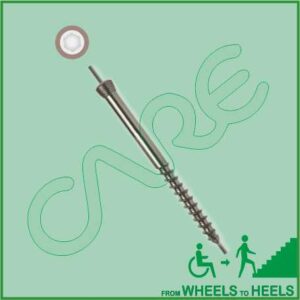Description
| Ref. No. Ti | Ref. No. SS | Length |
| LCP503240
LCP503245 LCP503250 LCP503255 LCP503260 LCP503265 LCP503270 LCP503275 LCP503280 LCP503285 LCP503290 LCP503295 LCP5032100 LCP5032105 LCP5032110 |
5032-40
5032-45 5032-50 5032-55 5032-60 5032-65 5032-70 5032-75 5032-80 5032-85 5032-90 5032-95 5032-100 5032-105 5032-110 |
40mm
45mm 50mm 55mm 60mm 65mm 70mm 75mm 80mm 85mm 90mm 95mm 100mm 105mm 110mm |
5 mm Locking Head Cancellous Screw “32mm Thread” Specification
- 5 mm Locking Head Cancellous Screw available lengths are 40mm, 45mm, 50mm, 55mm, 60mm, 65mm, 70mm, 75mm, 80mm, 85mm, 90mm, 95mm, 100mm, 105mm and 110mm.
- Screws available thread lengths are 16 mm thread, 32 mm thread and Fully threaded.
- 5 mm Locking Head Cancellous Screw is made from pure Titanium and SS 316L.
- Low-profile head helps reduce possibility of soft tissue irritation .
- Reverse-cutting flutes assist in screw removal.
- Choice of thread lengths offers best fit of threads into far bone fragment, for greater interfragmentary compression.
- Locking Head Cancellous screw thread profile uses deep cutting threads with a large pitch to increase resistance to pullout. The large pitch also accelerates screw insertion and removal.
- Self-drilling, self-tapping screw tip facilitates screw insertion by eliminating the need for predrilling and tapping in most cases.
- Any additional length sizes of this screw will be made on demand.
- This is Self Tapping Screw. Self Tapping Screws cuts its own thread while being driven into the bone. It makes a small hole while entering the bone which creates a tight friction fit between the threads. This helps fight vibration loosening and allows the parts to be taken apart if needed..
- Instruments are available for this screw such as Bone Taps, Combined Drill & Tap Sleeve, Counter Sink, Depth Gauge, Drill Bits, Drill Guide, Drill Sleeve, Hollow Mill Screw Removal, Reverse Measuring Device, Screw Drivers and Screw Holding Forceps etc.
5 mm Locking Head Cancellous Screw “32mm Thread” uses
5 mm Locking Head Cancellous Screw is intended for fracture fixation of large bones and large bone fragments.
This Screw is also indicated for:
- Femoral neck fractures
- Slipped capital femoral epiphyses
- As an adjunct to DHS in basilar neck fractures
- Tibial plateau fractures
- Ankle arthrodeses
- Pediatric femoral neck fractures
- Intercondylar femur fractures
- Sacroiliac joint disruptions
- Subtalar arthrodeses
Bone screws are the most commonly used orthopedic implants. There are many different types and sizes of screws for different types of bones. Most bone screws are made out of stainless steel or titanium alloys. The outer diameter, root diameter, and thread pitch and angle are important in determining screw mechanics.
In orthopedics, screws are typically described by their outer diameter, for example, a “5 mm Locking Head Cancellous Screw” has an outside diameter of 5 mm. The pitch of a screw is the linear distance travelled by a screw for one full turn of the screw. The screw advances by a distance equal to the distance between the threads with each full turn. Cortical screws have a lower pitch and therefore more number of threads. Locking Head Cancellous bone screws have a greater depth of the screw to increase the surface area and therefore improve the purchase, as the bone is weaker.
Screws function by converting the tightening torque into internal tension in the screw and elastic reactions in the surrounding bone. This creates compression between the fracture fragments that the screw is holding together. This Screw is typically inserted into holes drilled equal to the root diameter and are either self-tapping or are inserted tapped (threaded) holes. The torque to insert cortical bone screws can be high, so the screws must be properly inserted into the correct size drilled hole and designed to withstand insertion torque levels expected in cortical bone. Locking Head Cancellous bone screws have large, deep threads that grip the spongy bone well. Because of the relatively low strength of the locking head cancellous bone, failure of the screw itself during insertion is rare, but pull out can be an issue.
 CARE IMPLANTS & INSTRUMENTS
CARE IMPLANTS & INSTRUMENTS





